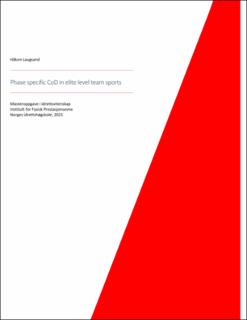| dc.description.abstract | Change of direction (CoD) is a fundamental skill in a variety of court- and field-based ball sports. Based on the force momentum relationship CoD performance is based on the ability to generate horizontal force. However, tests of physical performance tend to focus on the ability generate vertical force. Furthermore, CoD is made up of two phases (initial acceleration to deceleration and re-acceleration) that represents different qualities and not captured with the current outcome measurements of overall time. The aim of this study is to determine how different tests of physical performance (horizontal and vertical) relate to overall and phase specific change of direction outcome measurement. 15 male elite handball-players (age 21±1.6 years, height 192±6.5 cm, body weight 96 ± 10.8 kg) completed a battery of tests consisting of two linear unloaded sprints (20m) and the modified 505 test with two left and right foot turns from a two-point start prior to five left and right unilateral lateral jumps. Both CoD and lateral jumps were performed with a 3kg external load provided by a motorized resistance. Overall time was used as outcome measurement for both sprint and the m505 test with the additional phase specific times (phase 1a initial acceleration to deceleration and phase 1b re-acceleration) for the m505 test. Then, both leg press (LP) (pneumatic resistance) and 5 countermovement jump (CMJ) (force platform) was tested. From the leg press average concentric power (LPavg_power) was calculated, while both concentric peak (CMJcon_peak_power) and average power (CMJcon_avg_power) as well as peak eccentric peak power (CMJecc_peak_power) was calculated from the CMJ data. Relationships between test outcome measurements were determined using correlational analysis (Pearson r) with a significance level of p<0.05. Overall sprint time (2.83±0.11 s) had significant strong correlation with phase 1b (r= .77) , but neither with phase 1a (r= .10) nor overall time 505 (r= .32). Furthermore, Phase 1a had stronger correlation with overall time on the m505 test (r=.96) compared to phase 1b (r= .56, p<0.05), but the different phases did not correlate with each other (r=0.33, p>0.05). Neither leg press nor CMJ outcome variables were significantly correlated with neither sprint nor phase 1b time. However, LPavg_power (r=0.73), CMJcon_avg_power (r=0.59) and CMJcon_peak_power (r=0.54) significantly correlated m505 overall time, and LPavg_power (r=0.72), CMJcon_avg_power (r=0.61) and CMJcon_peak_power (r=0.58) significantly correlated phase 1a. Based on the lack of significant correlations between the different performance tests (sprint and CoD), especially for phase 1a, and that there is no significant correlations between phase 1a and 1b, it appears that CoD tests with phase specific analysis provide unique information that might be of important for ball sport athletes. Both leg press and CMJ outcome measurements were correlated with phase 1a and overall m505 time but not with phase 1b and linear sprint performance. Based on current findings it appears that phase specific assessment of m505 tests provide unique information not quantified with CMJ, leg press, lateral jump or linear sprint tests which can be important to performance in ball sport athletes. | en_US |
